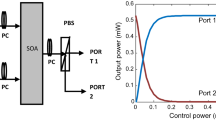Abstract
The fundamental principle and the characteristics of ternary optical computer, using horizontal polarized light, vertical polarized light and no-intensity to express information, are propounded in this paper. The practicability to make key parts of the ternary optical computer from modern micro or integrated optical devices, opto-electronic and electro-photonic elements is discussed. The principle can be applied in three-state optical fiber communication via horizontal and vertical polarized light.
Similar content being viewed by others
References
Yu Rongjin, Integration optics and photonics, Photoelectron · Laser (in Chinese), 1998, 9(2): 162.
Yu Yan (translator), Chen Min (corrector). Imperative computer revolution, International Trends of Science and Technology (in Chinese), 1998, (10): 9.
Song Jinsheng. Technology survey and developing trend of passive fiber elements, Electric Elements and Materials (in Chinese), 1998 (4): 19.
Shi Jianjun, Shi Yongji, Ferroelectric liquid crystal gates & optical computing, Semiconductor Photonics and Technology, 1999, 1(3): 179.
Gourley, P. L., Nanolasers, Scientific American, 1998, 278(3): 56–61.
Chen Dayi, Photomagnetic record technique, Electroacoustic Technology (in Chinese), 1999, (12): 29.
Shen Xuanjing, Qian Qingji, Zhang Xiaoxu, Photoelectric computer design based on symbol substitution algorithm, Optical Technology (in Chinese), 2000, 26(1): 62.
Mitkas, P. A., Betzos, G. A., Irakliotis, L. J., Optical processing paradigms for electronic computers, Computer, 1998, 31(2): 45–51.
Kwiat, P. G., Mitchell, J. R., Schwindt, P. D. D. et al., Grover’s search algorithm: an optical approach, Optics, 2000, 47(2/3): 257–266.
Zhang Zhemin, Jin Jinyan, Huang Gefan et al., Strain quantum-well laser with mixture of bipolarization and double wavelength, Optical Communication Research (in Chinese), 1998, (2): 46.
Wang Jun, Li Shiqu, Analysis formula of m-bit logical function and recursion of general Bent function, Applied Mathematics (in Chinese), 1999, 12(1): 115.
Poustie, A. J., Blow, K. J., Kelly, A. E. et al., Temporal evolution of amplitude restoration and thresholding in an all-optical regenerative memory, Journal of Modern Optics, 1999, 46(8): 1251–1254.
Author information
Authors and Affiliations
Corresponding author
Rights and permissions
About this article
Cite this article
Jin, Y., He, H. & Lü, Y. Ternary optical computer principle. Sci China Ser F 46, 145–150 (2003). https://doi.org/10.1360/03yf9012
Received:
Issue Date:
DOI: https://doi.org/10.1360/03yf9012




